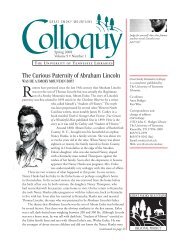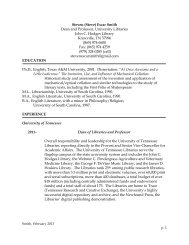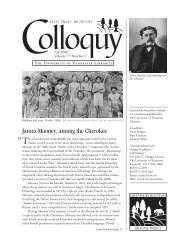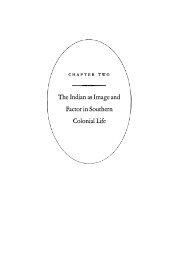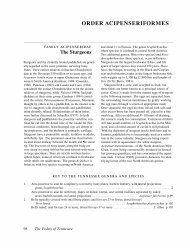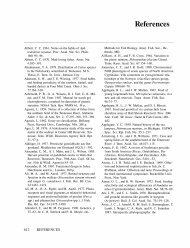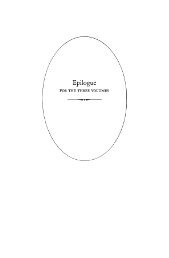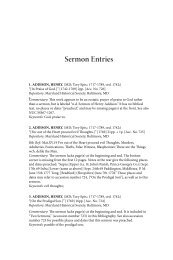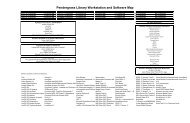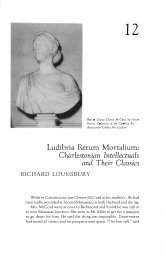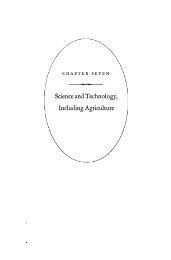Literature, Principally Belletristic - University of Tennessee, Knoxville
Literature, Principally Belletristic - University of Tennessee, Knoxville
Literature, Principally Belletristic - University of Tennessee, Knoxville
You also want an ePaper? Increase the reach of your titles
YUMPU automatically turns print PDFs into web optimized ePapers that Google loves.
· <strong>Literature</strong>, <strong>Principally</strong> <strong>Belletristic</strong> .<br />
But the poems <strong>of</strong> gallantry, serious or satiric, are not all classical or<br />
pastoral in origin. "A Riddle" in the January 22, 1732, issue, by "a Fair<br />
Correspondent," was reprinted in the Pennsylvania Gazette and replied to<br />
by another lady. It is concerned with "the Power <strong>of</strong> Letters:' Lucretia,<br />
despite her Roman name, in the issue <strong>of</strong> February 12, 1732, paraphrases<br />
in sixty-two lines the description <strong>of</strong> a harlot in the Proverbs 7, replying<br />
to Honestlls in an earlier number. On February 19 "Secretus" combines<br />
the pastoral setting and imagery with American subject matter, beginning<br />
with celebration <strong>of</strong> South Carolina's beauties :<br />
From Courts remote, and Europe's pompous Scenes,<br />
With Pleasure view what Nature's Care ordains.<br />
Here, various Flow'rs their blooming Beauties spread,<br />
The happy Swain, here seeks the Lawrel's Shade;<br />
Where, Nymphs unpractic'd in the Guiles <strong>of</strong> Art.<br />
Are form'd to warm the coldest Briton's Heart.<br />
Quite un-European is a poem mentioned under satire above, "The CAME<br />
LEON LOVER" with its defense or mock defense <strong>of</strong> amours "With the dark<br />
Beauties <strong>of</strong> the Sable Race" and "Sable's" submission <strong>of</strong> "Cameleon's Defence,"<br />
a quite feeble apologia.264 On March 25, 1732, "Dorinda" in twelve<br />
lines datelined Santee, March 7, 1731, praises the knowledge and wisdom<br />
<strong>of</strong> "Belinda," who had written on February 25. Here in the first year <strong>of</strong> the<br />
Gazette what appear to be female contributors dominate the poetry column,<br />
for these battles or loves <strong>of</strong> the sexes signed with female names are the<br />
principal poetic subject.<br />
Perhaps not <strong>of</strong> local origin is the unsigned "The Milk-Maid," eighty-two<br />
lines recounting the old tale <strong>of</strong> the buxom lass counting her chickens before<br />
they were hatched. On April 20, 1734, fifty-seven lines "To a Young Lady"<br />
again may be borrowed, as may be the poems on the ladies and sensibility<br />
on April 27, though "On an old Lover <strong>of</strong> a young Lady" on May 18, 1734,<br />
seems locally authored and locally set. On June 15 "a young Person" addressed<br />
"Flavia" in twenty-nine lines, which the lady herself sent to the<br />
Gazette with a letter to editor Timothy saying this first endeavor by a<br />
young person should be printed.<br />
Two facetious poems on Orpheus and Eurydice, one by a bachelor and<br />
the other by a married man, appeared on December I, 1737, as an "ex<br />
plication <strong>of</strong> the fable." During the 17 40S and the Whitefieldean furor<br />
there was very little decent light lyric verse, original or borrowed, which<br />
found space in the periodical, though in the issues <strong>of</strong> August 22 and November<br />
21, 1743, there were some amusing "gallant" exchanges. On<br />
March 4, 175 I, "The Maid's Soliloquy," by "a Lady <strong>of</strong> this Province,"<br />
proves to be a rather interesting effusion <strong>of</strong> thirty lines beginning<br />
1493



